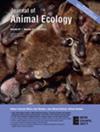An experimental test of the importance of isolated trees for frog diversity in tropical landscapes
IF 3.7
1区 环境科学与生态学
Q1 ECOLOGY
引用次数: 0
Abstract




热带景观中孤立树木对青蛙多样性重要性的实验测试。
孤立的树木在破碎的景观中很显眼,通常被认为是“基石结构”,尽管它们占据的面积很小,但却具有重要的生态作用。它们也被视为“生物多样性焦点”,因为它们可能比附近的开阔地区拥有更高的丰度和物种丰富度。然而,这些建议还没有经过实验检验。我们以实验池塘和两栖动物为模型系统,测试了大西洋森林生物多样性热点地区孤立树木对生物群落的重要性。我们建造并取样了28个人工池塘,10个靠近连续森林的边缘,9个在孤立的树下,9个在开阔的牧场上。为了检验不同处理间两栖动物群落结构的差异,我们量化了群落丰度、本地物种丰富度和群落组成。我们还测试了4种数量优势物种(Physalaemus signifer, Leptodactylus latrans, Rhinella ornata和sinax affs . x-signatus)在不同处理下的丰度是否存在差异。最后,我们比较了不同处理的物种丰富度。孤立树下和林缘的池塘群落丰度、象征小檗和花小檗的丰度、总物种丰富度(景观水平)均高于开阔牧场的池塘。孤立树下池塘的群落组成与连续林边缘池塘相似,而开放牧场群落的群落组成明显不同。我们的研究结果提供了实验证据,表明孤立的树木有助于增加森林砍伐地区池塘中无尾动物的物种丰富度和群落丰富度,使当地群落更接近森林边缘。我们建议在森林砍伐地区保护和种植孤立的树木,特别是在天然池塘附近,以及恢复孤立树木附近的池塘。这些相对低成本的行动可以大大有助于增加破碎景观中无尾猿群落的丰度和物种丰富度。
本文章由计算机程序翻译,如有差异,请以英文原文为准。
求助全文
约1分钟内获得全文
求助全文
来源期刊

Journal of Animal Ecology
环境科学-动物学
CiteScore
9.10
自引率
4.20%
发文量
188
审稿时长
3 months
期刊介绍:
Journal of Animal Ecology publishes the best original research on all aspects of animal ecology, ranging from the molecular to the ecosystem level. These may be field, laboratory and theoretical studies utilising terrestrial, freshwater or marine systems.
 求助内容:
求助内容: 应助结果提醒方式:
应助结果提醒方式:


